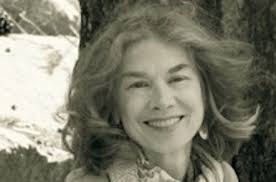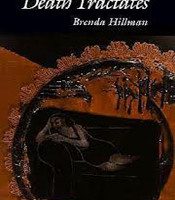What would it mean to be true about the actuality of death? Poets are drawn to that great subject, because its awesomeness (in the old sense of that word) is a challenge to users of language, and language itself.
Brenda Hillman explains in a short introduction to her 1992 collection Death Tractates that she wrote the poems of the book in the time right after her “closest female mentor died suddenly at a young age.” The poems reflect that shock of sudden death, and the great emotions that result, while also being weirdly logical, attentive to detail, speculative, and brilliant. A tractate is a kind of systematic exploration of a subject. It implies a sustained effort to fully understand something, through a series of attempts. To me the word is most obviously associated with Wittgenstein’s early work, The Tractatus Logico-Philosophicus, which he wrote the notes for while he was a soldier in WWI. In its final form it became a series of very short, often gnomic (at least to me) declarative statements about language, reality, knowledge, etc.
Like Wittgenstein’s Tractatus, Hillman’s Death Tractates are an attempt to logically respond to traumatic events. But Hillman’s are far more than logical propositions. They are, together, the sustained record of an individual mind mustering all of its faculties to try to come to terms with a catastrophe.
Because we need to call the feeling one has after a great loss something, we call it “grief,” but anyone who has experienced it knows that this is just a word assigned to what is, in its shifting, horrible, massive complexity, unnameable. This book is an effort to rename this feeling. It should take at least that number of words and pages to begin to do so. One could say the entire book is a new name, the name of this emotion one can feel after such a loss.
The most difficult thing for a reader of the book might be the intensity of the feelings, and also at times because language is trying to reach for some kind of knowledge or understanding that seems impossible, given the horrible hugeness of the absence of the one who has died. The reader feels the poet’s intense desire to only say true things in the poems, in honor of her friend and her passing. The book is not otherwise difficult to understand, or, it is only difficult in the way all poetry is and should be. The poet does what poets do: reactivates words, makes odd associations, connects things that do not ordinarily belong together in order to create deeper meaning. At the beginning of “Yellow Tractate,” she writes:
Smart daffodils! They waited
till the cold snap was over, then brought themselves
into the corridor, like lamps of pity –
I have never heard anyone say “lamps of pity” before, nor have I ever heard anyone compare daffodils to lamps of anything, though when you look at a daffodil, you can see that they do, in fact, look a lot like that. The poet sees things in the world transform into other things, and this seeing happens in language, in metaphor. Flowers become lamps of pity, and in the way of all metaphors, all the elements refract with new meaning in relation to each other. Flowers are lamps, lamps have pity, flowers have pity, pity has flowers. If we sit with that moment, we have a lot to think about.
 The more I read this passage, the more I love that odd word “corridor.” We usually think of corridor as having to do with buildings or trains, a passageway in an interior space. But a secondary meaning, the one used here, is of a long narrow piece of land. If we happen to know this, we know the poet is walking outside, looking at flowers. But for most of us our first association will be with the interior space, the hallway, so most of us at least at first will imagine we are somewhere inside. I believe the poet was drawn to this word precisely because of this duality, its claustrophobic connotation. The word “corridor” actually comes from the Latin word “to run,” and probably has to do with something military, the way a group of people would have to move quickly, in peril, through a narrow strip of land to get from one place to another.
The more I read this passage, the more I love that odd word “corridor.” We usually think of corridor as having to do with buildings or trains, a passageway in an interior space. But a secondary meaning, the one used here, is of a long narrow piece of land. If we happen to know this, we know the poet is walking outside, looking at flowers. But for most of us our first association will be with the interior space, the hallway, so most of us at least at first will imagine we are somewhere inside. I believe the poet was drawn to this word precisely because of this duality, its claustrophobic connotation. The word “corridor” actually comes from the Latin word “to run,” and probably has to do with something military, the way a group of people would have to move quickly, in peril, through a narrow strip of land to get from one place to another.
Whether or not the poet knew all this about the word “corridor,” I very much doubt she was consciously aware of it while writing this poem. When a poet writes, she feels instinctively if a word is correct. She could easily have written other words there: the daffodils could have brought themselves into the meadow, into the field, into the garden, and so on. But the poet’s brain chose corridor, she knew it was the right word, probably because it is in a sense the wrong word, the word we were not waiting for. This is what Aristotle meant when he talked about poets having “an eye for resemblances,” for seeing similarities and connections that others do not.
The poet often makes the choice of a word based on the way it sounds, how it sounds right. The way a words sounds “right” to a poet has to do with something much more than only sound itself: it is the resonance of all the meanings the word has carried and accumulated over thousands of years. Because of all the reading and thinking poets have done about words and language, and their intense, weird love of the material of language itself, poets just “know” when something is right, in the same way Cézanne from his intimate lifetime relations with paint “knew” that splotch of green had to migrate above his right eye in “Self Portrait with Palette,” or the composer knows the oboes at a certain moment absolutely must start doing whatever oboes do.
 In this way Hillman’s poems are difficult as all poems are: they ask us to be closely attentive to the meanings of words, to read slowly, to think about the resonances of what is being said, and most important, to accept strangeness in connections between things. These are not the difficulties ordinarily and unfairly attributed to most poetry: that is does not say what it means, that it has a private, coded, symbolic language, that it hides what it is saying. Here, as in all great poetry, the opposite is true.
In this way Hillman’s poems are difficult as all poems are: they ask us to be closely attentive to the meanings of words, to read slowly, to think about the resonances of what is being said, and most important, to accept strangeness in connections between things. These are not the difficulties ordinarily and unfairly attributed to most poetry: that is does not say what it means, that it has a private, coded, symbolic language, that it hides what it is saying. Here, as in all great poetry, the opposite is true.
The only moment that might be a bit difficult for a reader in terms of basic comprehension occurs, I think, in the very first lines of the book. Mostly I think this is because we are encountering this poetic voice for the first time, and it is a kind of shock, as it always is, for us to move from our ordinary world of language into poetry. It is also because the poet is deeply endeavoring to be scrupulously honest to the actuality of the loss. In other words, she is trying to talk very honestly into the face of something that resists language. Here is how the book begins:
First Tractate
That the soul got to choose. Nothing else
got to but the soul
got to choose.
That it was very clever, stepping
from Lightworld to lightworld
as an egret fishes through its smeared reflections —
through its deaths —
for it believed in the one life,
that it would last forever.
These first two stanzas have some peculiarities. First, there is the incompleteness of the sentences, each beginning with “that.” This seems to me to be the place that the poet is most closely emulating the tractate form: these are propositions, that she will make and then consider. What is left out is the first part of the statement. It’s as if the fact of the soul choosing is so powerful, that it can’t be contextualized. One could imagine such sentence starting in different ways: “What is interesting is that …” “What is horrible is that …” “What is amazing is that …” But the speaker, the poet, doesn’t know how she feels. She can’t write the first half of that sentence yet, because she doesn’t yet know. Perhaps she will only know how she feels about what the soul has done, it’s so-called choice to move on from this world to another, through the process of writing the poem. Writing a complete sentence that infers otherwise would be a dishonesty.
There is the idiosyncratic distinction between Lightworld (capital L) and lightworld (small l), which seems to be a way of capturing what the soul did when it left this world for the next. And there is the comparison of the soul to the egret, that “fishes through its smeared reflections.” Today, on my walk around Lake Merritt where I live, I saw a snowy egret (a small white bird with a black beak) doing exactly that. It has yellow feet, and very seriously and slowly hunts looking down at the water, sneaking up on something we can’t see. Here is how the City of Oakland website describes the egret: “Commonly seen around the edges of the lake at low tide, stirring the water with its bright yellow feet to lure small fish and crustaceans into striking range. Fluffy nuptial plumage in March and April is part of its dramatic mating display. Like the great egret they nest and roost in trees on the islands and at times it seems as if the trees are blooming snowy egrets.”
 At times indeed. The idea that the bird is not just fishing through its reflections, but “through its deaths,” further complicates matters. Here the poet is considering whether every kind of change (from moment to moment, as the reflection in the water changes, and then changes again) is a kind of death. If so maybe the death of the body, and the movement of the soul from one state to another, is just another kind of change. Maybe this change should not be so desperately mourned? Though the poet doesn’t say it, this is close to a Buddhist or Vedic idea about death.
At times indeed. The idea that the bird is not just fishing through its reflections, but “through its deaths,” further complicates matters. Here the poet is considering whether every kind of change (from moment to moment, as the reflection in the water changes, and then changes again) is a kind of death. If so maybe the death of the body, and the movement of the soul from one state to another, is just another kind of change. Maybe this change should not be so desperately mourned? Though the poet doesn’t say it, this is close to a Buddhist or Vedic idea about death.
The “it” in these first two stanzas is the soul. One of easiest ways to get lost in a poem is to lose track of the pronouns, and their referents (and one of the classic mistakes many poets make, though not Hillman, is to lose track of those things themselves, thus hopelessly confusing the reader).
These first two stanzas, which are really an imagining on the part of the poet the soul of the departed, are followed by a much more anecdotal voice. It is almost as if the poem begins again, which to me makes a lot of sense. The whole book will be a series of attempts to write into this loss, over and over again. If those first two stanzas are a bit elusive, the rest of the poems in the book are not. The “First Tractate” continues:
When she had just started being dead I called to her.
Plum trees were waiting to be entered,
the swirling way they have,
each a shower of
What.
Each one full of hope,
and of the repetitions —
When she had been dead a while
I called again. I thought she was superior somehow
because she had become invisible,
because she had become subtle
among the shapes —
and at first she didn’t answer, everything answered.
The plum trees (common to the Bay Area, with their bright purple canopies) seem to be a place where the poet for a moment imagines she could go, a place to get lost, maybe to forget. But her terrible confusion does not allow her even a moment of solace: entering the plum trees would leave her with the same great question. Even ordinary phenomena like trees and leaves and fruit seem unnameable to her. That moment, with the capital “What,” reminds me of Dickinson, because of the capital letter, and the use of the dash, and also probably also because of the word “called,” one of the two words written on Dickinson’s tombstone: “Called Back.” Often I used to visit her grave in Amherst, Massachusetts, when I was first studying poetry in Amherst, to ask for help or just put a little trinket on top of her gravestone (what she called in one of her poems “her granite lip”). Perhaps in my worst, most desperate moments, I expected her to answer. In this poem, the departed does not answer, but everything else does.





3 responses
Matthew, thank you, a beautiful review.
A friend mailed me this book shortly after my father’s sudden death almost exactly 5 years ago. Every year, at the anniversary of his death, I remember this book and today I saw this review and I will go back to Death Tractates. Thanks for getting it right.
Death Tractates is a collection that ushered me through the sudden and unexplained loss of my mother over 20 years ago. I return to it again and again for its spiritual and emotional nourishment, as well as its artful making. Thank you for your thoughtful response to it.
Click here to subscribe today and leave your comment.